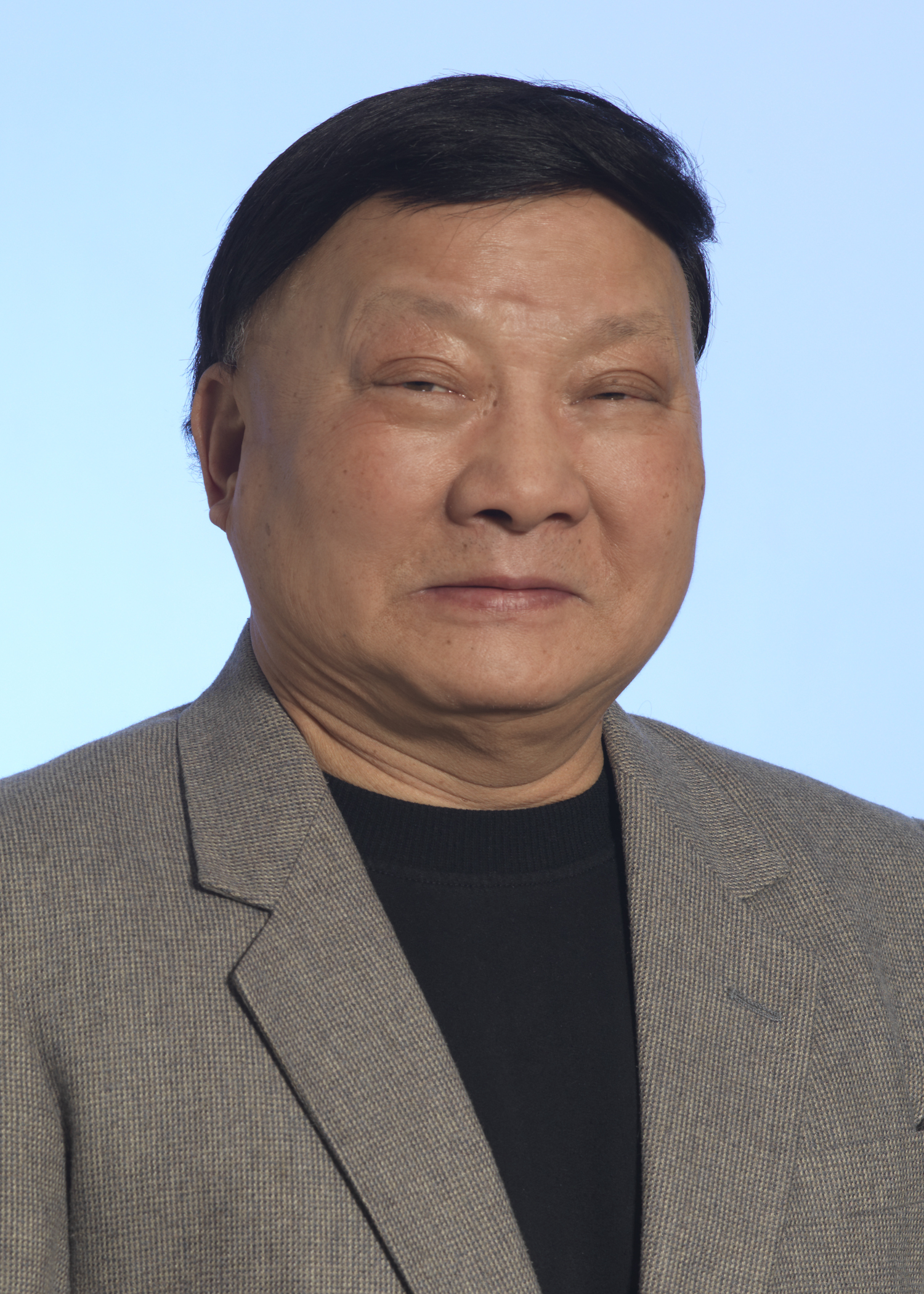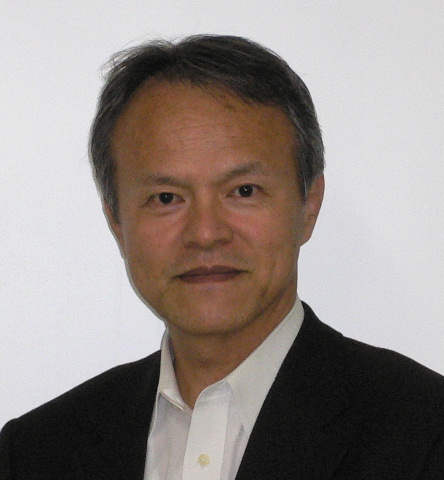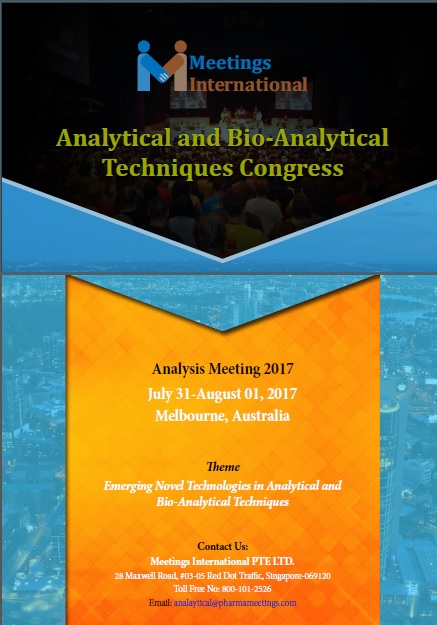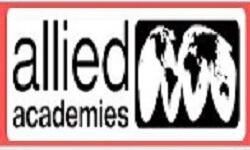
Analysis Meeting 2017

Theme: Emerging Novel Technologies in Analytical and Bioanalytical Techniques
About Conference
Meetings International in collaboration with EuroSciCon welcomes you to attend Analytical and Bio-Analytical Techniques Congress to be held during July 31-August 01, 2017 in Melbourne, Australia. The main theme of the conference is “Emerging Novel Technologies in Analytical and Bio-Analytical Techniques”.
Analysis Meeting 2017 will cover all perspectives where analytical chemistry plays a role including fundamental and applied sciences. It will offer plenary and keynote presentations on cutting-edge topics by universally eminent pioneers of the field, followed by contributed talks and poster presentations to stimulate interdisciplinary discussions. In addition, a young researcher’s session will be conducted to provide opportunities for and encourage Ph.D. students and postdocs to share their discoveries.
In the light of this theme, the Meetings International aims to provide a forum for international researchers from different zones of pharmacogenomics research, DNA analysis, method development and validation by providing a platform for critical analysis of new data, and to share most recent cutting-edge research findings and results about all aspects of Analytical and Bioanalytical strategies.
Analytical Chemistry spans nearly all areas of chemistry but involves the improvement of tools and strategies to measure physical properties of substances and apply those techniques to qualitative analysis and quantitative analysis of species in a wide variety assortment of settings
EuroSciCon, founded in 2001 is a UK based independent life science Events Company with predominantly business and academic client base. The key vital target of EuroSciCon is to impart science and medical research between academia, clinical practice and the pharmaceutical industry. A large portion of its events are in Europe and London or live streamed. EuroSciCon extended its operations to global in relationship with Meetings International, Singapore. Every single significant meetings of EuroSciCon and Meetings International are authorized with Continued Professional Education (CPD), Continued Education (CE), and Continued Medical Education (CME) Credits.
Why to Attend?
With individuals from around the globe concentrated on learning about Analytical Chemistry, Pharmaceutical chemistry, Chromatography, Mass spectrometry and Pharmacology; this is your single best opportunity to reach the biggest array of participants. Lead exhibits, distribute information, meet with present and potential clients, make a splash with a new product line, and receive name recognition at this 2-day occasion. World-renowned speakers, the latest procedures, and the newest updates in fields are hallmarks of this conference.
Who should attend and Who You’ll Meet?
Executives, Presidents & CEO from organizations, Chemical Instrument Vendors, Professors and Students from Academia in the study of Analytical and Bioanalytical Sciences. Delegates from different Pharma & Instrumental companies from everywhere throughout the world. .
• Research Heads from Research Centers
• Analytical specialists in Pharmaceutical and Life science
• Leads from Pharma and Chemical companies.
• Industrial expertise working with various novel solid and liquid columns
• Marketing groups of Industries with novel items to show case at the gathering
• Directors and Professors from Universities and Institutions
• Post-doctoral and PhD students working on analytical method improvement
• Theoretical researchers working on deriving analytical hypotheses
• Analytical academic scientists’ analysts and research scholars
• Relevant Graduate and Post graduate students
Market Analysis
The advancement of the Analytical and Bio-analytical Techniques brought a dynamic discipline for which the future holds many energizing opportunities to further change. The principle impact of bionalysis in the pharmaceutical business is to get a quantitative measure of the drug and its metabolites. The reason is to perform the pharmacokinetics, toxic kinetics, and bioequivalence and exposure reaction like pharmacokinetic/pharmacodynamic studies. Different bioanalytical strategies are performed in bioanalytical studies for example hyphenated techniques, chromatographic techniques, and ligand binding assays.
The life science instrumentation market is anticipated achieve USD 64.52 Billion by 2021 from USD 46.36 Billion in 2016, at a CAGR of 6.8% between 2016 and 2021. Factors such as growing pharmaceutical R&D ventures, expanding food safety concerns, availability of public and private funding for life science research studies, innovative advancements in analytical instruments, and stringent drug development controls in developed countries are propelling the development of the global life science instrumentation market.
The convenient analytical instruments market is anticipated to reach USD 9.55 Billion by 2020 from USD 8.10 Billion in 2015, at a CAGR of 3.3%. Versatile analytical instruments are lightweight handheld instruments with simple infrastructure and convey instant results, in any location and under any climate condition.
The Global Cell Separation Techniques Market is ready to develop at a CAGR of around 10.6% throughout the following decade to reach roughly $6.04 billion by 2025. Some of the prominent trends that the market is witnessing include growing infectious diseases in emerging nations, increasing stem cell research, technological development of cell separation strategies and development opportunities/investment opportunities.
The worldwide expansion of the market will be driven by biotechnology and pharmaceutical companies as they search for the next new medications to help an increasingly huge and old population. It is these enterprises that governments rely on to keep their voters healthy — and the industries are often at the forefront of developing new strategies and procedures as they look for cost-effective drug pipelines.
Track 1:Novel Approaches to Analytical and Bio-Analytical Methods
Analytical chemistry is that the study of the partition, identification, quality control and quality confirmation of the synthetic parts of natural and artificial materials. The maintenance of a desired coveted level of value in an exceedingly service or product, particularly by means that of consideration to every phase of the strategy of delivery or generation. Bio-analytical Chemistry could be a sub-category of Analytical Chemistry that covers the measuring of medicine, Ion sensors, Proteins and DNA Sequences in unnatural samples or concentrations. Amend evaluation of the drug samples is extremely important for several scientific endeavours which can not hinder the result. Therefore the Bio-Analytical Techniques are in the main focussed to induce the correct results of the drug sample to supply a correct outcome.
Track 2 : New analytical Instrumentation and Equipment
NMR analysis is utilized in separation of complex l and natural samples. Recent advances in mass chemical analysis area unit facultative enhanced analysis of endogenous metabolites. Here we have a tendency to discuss numerous issues relevant to developing High-Performance Liquid Chromatography, electro spray ionization, mass chemical analysis ways for focused metabolomics (i.e., menstruation of dozens to many numerous metabolites).Lab-on-a-chip devices area unit an arrangement of MEMS instruments and occasionally indicated by "Micro Total Analysis Systems" (µTAS) still.
Track 3 : Applications of Analytical and Bio-Analytical Methods
Bio-Analysis might be a sub-discipline of analytical chemistry covering the quantitative activity of xenobiotic (medications and their metabolites, and organic molecules in unnatural locations or concentrations) and biotic (large scale and small scale molecules, proteins, DNA, giant molecule medicine, metabolites) in natural frameworks. Applications for analytical and Bio-Analytical method development and validation are as per the following: biological safety test, clinical support, separation of mixture of compound, drug investigation. Importance of understanding proteomics and process of food science is essential, and can be discussed by using separation techniques.
Track 4 :Biosensors
Biosensor refers to a powerful and innovative analytical device that combines a transducer with a biological sensing element. It is an analytical device which converts a biological response into an electrical signal. Biosensors obtained huge attention in recent years in medicine and nanotechnology. Biosensor products have found versatile applications in various industries including food and beverages, agricultural, environmental, medicinal diagnostics, and pharmaceutical enterprises and many more.
Track 5 : Electro-Analytical Techniques
With the impressive advances observed in analytical instrumentation, it was of important to study recent trends in the field of electro analysis of drugs. Potentiometric, voltammetric and amperometric strategies were scrutinized both in terms of historical evolution and in terms of possibilities with respect to the analysis of drugs in different frameworks. With respect to the former, it appeared that various original unique electrodes (for drugs and ions) have been studied and several ion-selective electrodes have been effectively popularized. Changes are still expected in this field in order to discover more robust membrane matrices and to minimize the surface fouling. Electrochemistry is appropriate for trace metal analysis.
Track 6 : Diagnostic Assays and Test Kits in Analytical Chemistry
Immune chromatographic Assays moreover refered to as Lateral Flow Tests or simply Strip Tests unit of estimation immunoassays performed on a simple to utilize strip format. Amount of your constant quantitative PCR is incredibly right and less effortful than current quantitative PCR ways in which. Needs generally bit of sample, Adequate level of sensitivity, simple manufacture in large scale ,Stability of the last word product at temperature (time span of usability) , β-D-Glucan as a Diagnostics Adjunct for Invasive contagious Infections: Validation and drug improvement, and Performance in Patients with Acute Myelogenous blood cancer.
Track 7 : Forensic Applications of New Analytical Technologies
Forensic investigations include the discovery and characterization of evidence that can be utilized to reproduce a chronology of occasions connected with the commission of a crime or different matters being mediated. As they become available, increasingly sophisticated analytical tools and techniques are being utilized to recognize and discriminate evidence
The term forensic science is connected with the utilization of analytical tools and strategies in the discovery of evidence considered significant in the investigation of a crime or in some other legal proceeding. Sources of evidence may be organic samples from persons living or dead, physical objects and their disposition, deposited trace materials, alteration or disruption of a setting, in addition incidental reference associating these data. The evolving advancing force and sophistication of analytical instrumentation has made it possible to perform forensic investigations at ever smaller size scales with more noteworthy and better scopes of differentiation. Accordingly, it is now possible to reveal uncover evidence formerly indiscernible or inaccessible
Track 8 : Analytical Techniques in Pharmacogenomics
An analytical technique could likewise be a strategy that's accustomed ensures the concentration of a matter or substance. Future analytical techniques in DNA analysis should to be essential to induce absolute leads to medication the foremost normal techniques utilised in Analytical chemistry unit space are follows: titrimetric, Electrochemistry ways amid which, still as potentiometery and voltammetry; spectroscopy, supported the differential interaction of the Analyte. Forensic DNA examination, testing is seriously hampered by a developing backlog of compound samples by exploitation dHPLC.
Track 9 : Analytical Techniques in Immunochemistry
Analytical techniques modify researchers to take a look at complicated relationships between variables and those procedures are Regression Analysis, Grouping ways, Multiple Equation Models. Chemistry that investigates the study of the molecular mechanisms underlying the performance of the system, especially the character of antibodies, antigens and their interactions. The preeminent common diagnostic ways include: diagnostic assay, Endoscopy, Diagnostic, Blood Tests, immunochemical assay. The super molecule recognized by the bioassay is generally remarked as Associate in Nursing "Analyte" and is in several cases a macromolecule. Analytes in organic fluids like body fluid or territory unit regularly measured mistreatment immunoassays for medicinal and analysis functions.
Track 10 : Advances in Chromatography and Mass Spectrometry
Chromatography and Mass spectrometry is utilized for analysis of organic compounds. Electro spray ionization (ESI) could be a method utilized in mass spectroscopic analysis. As contrast with chromatography and mass spectrometry .HPLC is more adaptable informative and trusted by the industry individuals. Recent advances in sample preparation methods to beat challenges encountered throughout measuring of little molecules from bio fluids mistreatment LC-MS. For Measuring, observation and protective your critical Investments Analytical chemistry instruments are utilized. Worldwide Bio-Analysis seminars are conducted and those particularly applied for chromatography assays, ligand binding assays to know more advances.
Track 11 : Regulatory Issues and Biosafety Challenges in Bio-Analysis
Liquid chromatography-mass spectrum analysis might be a key analytical technique that blends the physical separation capabilities of fluid activity with the mass spectrometry analysis capabilities of spectrometry analysis.LC-MS system is utilized for fast and mass directed purification of natural-products extracts and new molecular entities necessary to food, pharmaceutical, agrochemical and diverse enterprises. LC-MS is sometimes used in drug development research at wide range of stages, impurity identification, quantitative Bio-Analysis, and control. FDA has propelled testing of current quality testing of traditional medicines among medicine patients throughout drug advancement. Traditional Chinese Medicine is a healing system developed in China more than 2,200 years back, incorporating treatments that are in some cases. One of its directing standards is to dispel evil and support the good. In addition to treating illness, Traditional Chinese Medicine concentrates on reinforcing the body's defences and enhancing its ability for healing herbs and to maintain health.
Track 12 : Pharmaceutical Analytical Techniques
Pharmaceutical Analytical strategies deal with the procedure or different procedure to identify and/or quantify a substance, the components of a pharmaceutical solution or mixture or the determination of the structures of chemical compounds procedure in the formulation of pharmaceutical product.
Track 13 : Environmental Analytical Aspects
Environmental chemistry is that the scientific investigation of the chemical and chemical science phenomena that happens in common places. Common analytical techniques utilized for quantitative determinations in environmental chemistry exemplify classical wet chemistry, like menstruation, titrimetric and chemistry methodologies. Environmental analytical chemistry is the scientific study of the chemical and organic chemistry phenomena that happens in natural places sometimes due to climate changes in the atmosphere pests attaches the crops. To keep away from loss of fertility and food safety in crops pesticides are used. Quantitative qualitative analysis might be a key a part of environmental chemistry, since it gives the information that frame most environmental studies or environment pollution studies
Track 14 :Biomarker Bio analysis and Regulations:
The part of biomarkers in medication disclosure and advancement has picked up priority throughout the years. As biomarkers end up noticeably incorporated into medication advancement and clinical trials, quality confirmation and specifically examine approval ends up plainly basic with the need to set up institutionalized rules for investigative techniques utilized as a part of biomarker estimations. New biomarkers can alter both the advancement and utilization of therapeutics, however is dependent upon the foundation of a solid approval prepare that locations innovation reconciliation and strategy approval and in addition administrative pathways for productive biomarker improvement. This point of view concentrates on the general standards of the biomarker approval handle with an accentuation on examine approval and the collective endeavours attempted by different divisions to advance the institutionalization of this method for productive biomarker improvement. Biomarkers are assuming an inexorably vital part in medication disclosure and improvement from target ID and approval to clinical application, accordingly making the general procedure a more normal approach.
The role of biomarkers in rational drug development has been a major focus of the Food and Drug Administration (FDA) critical path initiative and the National Institutes of Health (NIH) roadmap, while the overwhelming majority of biomarkers are proteins used as surrogate end points for drug development, diagnostic biomarkers may also prove useful for understanding the biology of the disease. Successful biomarker development depends on a series of pathway approach that originates from the discovery phase and culminates in the clinical validation of an appropriately targeted biomarker.
Biomarkers are now increasingly used in the pharmaceutical industry for early proof-of-concept studies and, furthermore, much research is focusing on the development of diagnostic and predictive biomarkers for point-of-care biosensor systems in the clinical environment and beyond.
Sub Tracks:
Challenges of Identifying Biomarkers
Standardization and Regulation of Biomarkers
Biomarker Technology Innovation
Future of Biomarkers
Collaborating in Biomarker Assay Qualification & Validation
Integrating Biomarkers into Drug Development
- Novel Approaches to Analytical and Bio-Analytical Methods
- New Analytical Instrumentation and Equipment
- Applications of Analytical and Bio-Analytical Methods
- Biosensors
- Electro-Analytical Techniques
- Diagnostic Assays and Test Kits in Analytical chemistry
- Forensic Applications of New Analytical Technologies
- Analytical Techniques in Pharmacogenomics
- Analytical Techniques in Immunochemistry
- Advances in Chromatography and Mass Spectrometry
- NanoAnalytics
- Pharmaceutical Analytical Techniques
- Analytical Techniques for Natural Product Research
- Regulatory Issues and Biosafety Challenges in Bio-Analysis
- Environmental Analytical Aspects
- Biomarker Bio analysis and Regulations:
- Journal of Chemistry
- Journal of Pharmaceutical Analysis
- Der Chemica Sinica
- Insights in Analytical Electrochemistry
5 Organizing Committee Members
7 Renowned Speakers
Takeshi Furuhashi
Nagoya University, Nagoya,
Japan
Anas Abdel Rahman
King Faisal Specialist Hospital and Research Center (KFSHRC)
Saudi Arabia
Dr. Oman Zuas
MiC-LIPI
Indonesia
Rashida Bashir
Swinburne University
Australia
Dr. Hashem Akhlaghi
Islamic Azad University, Sabzevar
Iran
Dr. Rampal Pandey
Dr.Harisingh Gour Central University Sagar(MP),India
India
Dr. Vinod K. Tiwari
Banaras Hindu University
India



































































































































